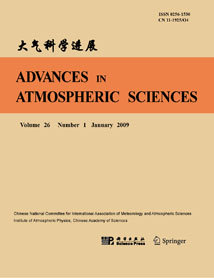| [1] |
LIU Ge, WU Renguang, ZHANG Yuanzhi, and NAN Sulan,
2014: The Summer Snow Cover Anomaly over the Tibetan Plateau and Its Association with Simultaneous Precipitation over the Mei-yu-Baiu region, ADVANCES IN ATMOSPHERIC SCIENCES, 31, 755-764.
doi: 10.1007/s00376-013-3183-z
|
| [2] |
Shuo JIA, Jiefan YANG, Hengchi LEI,
2024: Case Studies of the Microphysical and Kinematic Structure of Summer Mesoscale Precipitation Clouds over the Eastern Tibetan Plateau, ADVANCES IN ATMOSPHERIC SCIENCES, 41, 97-114.
doi: 10.1007/s00376-023-2303-7
|
| [3] |
YOU Wei, ZANG Zengliang, PAN Xiaobin, ZHANG Lifeng, LI Yi,
2015: Statistical Analysis of Thunderstorms on the Eastern Tibetan Plateau Based on Modified Thunderstorm Indices, ADVANCES IN ATMOSPHERIC SCIENCES, 32, 515-527.
doi: 10.1007/s00376-014-4039-x
|
| [4] |
ZHU Weijun, Yongsheng ZHANG,
2009: Summertime Atmospheric Teleconnection Pattern Associated with a Warming over the Eastern Tibetan Plateau, ADVANCES IN ATMOSPHERIC SCIENCES, 26, 413-422.
doi: 10.1007/s00376-009-0413-5
|
| [5] |
Nan GE, Lei ZHONG, Yaoming MA, Yunfei FU, Mijun ZOU, Meilin CHENG, Xian WANG, Ziyu HUANG,
2021: Estimations of Land Surface Characteristic Parameters and Turbulent Heat Fluxes over the Tibetan Plateau Based on FY-4A/AGRI Data, ADVANCES IN ATMOSPHERIC SCIENCES.
doi: 10.1007/s00376-020-0169-5
|
| [6] |
Fangchi LIU, Xiaojing JIA, Wei DONG,
2024: Changes in Spring Snow Cover over the Eastern and Western Tibetan Plateau and Their Associated Mechanism, ADVANCES IN ATMOSPHERIC SCIENCES, 41, 959-973.
doi: 10.1007/s00376-023-3111-9
|
| [7] |
Joshua TALIB, Omar V. MÜLLER, Emma J. BARTON, Christopher M. TAYLOR, Pier Luigi VIDALE,
2023: The Representation of Soil Moisture−Atmosphere Feedbacks across the Tibetan Plateau in CMIP6, ADVANCES IN ATMOSPHERIC SCIENCES, 40, 2063-2081.
doi: 10.1007/s00376-023-2296-2
|
| [8] |
Lihua ZHU, Gang HUANG, Guangzhou FAN, Xia QU, Guijie ZHAO, Wei HUA,
2017: Evolution of Surface Sensible Heat over the Tibetan Plateau Under the Recent Global Warming Hiatus, ADVANCES IN ATMOSPHERIC SCIENCES, 34, 1249-1262.
doi: 10.1007/s00376-017- 6298-9
|
| [9] |
Guoxiong WU, Bian HE, Anmin DUAN, Yimin LIU, Wei YU,
2017: Formation and Variation of the Atmospheric Heat Source over the Tibetan Plateau and Its Climate Effects, ADVANCES IN ATMOSPHERIC SCIENCES, 34, 1169-1184.
doi: 10.1007/s00376-017-7014-5
|
| [10] |
Chuandong ZHU, Rongcai REN, Guoxiong WU,
2018: Varying Rossby Wave Trains from the Developing to Decaying Period of the Upper Atmospheric Heat Source over the Tibetan Plateau in Boreal Summer, ADVANCES IN ATMOSPHERIC SCIENCES, 35, 1114-1128.
doi: 10.1007/s00376-017-7231-y
|
| [11] |
Yizhe HAN, Dabang JIANG, Dong SI, Yaoming MA, Weiqiang MA,
2024: Time-lagged Effects of the Spring Atmospheric Heat Source over the Tibetan Plateau on Summer Precipitation in Northeast China during 1961–2020: Role of Soil Moisture, ADVANCES IN ATMOSPHERIC SCIENCES, 41, 1527-1538.
doi: 10.1007/s00376-023-2363-8
|
| [12] |
Haoxin ZHANG, Weiping LI, Weijing LI,
2019: Influence of Late Springtime Surface Sensible Heat Flux Anomalies over the Tibetan and Iranian Plateaus on the Location of the South Asian High in Early Summer, ADVANCES IN ATMOSPHERIC SCIENCES, 36, 93-103.
doi: 10.1007/s00376-018-7296-2
|
| [13] |
DUAN Anmin, WU Guoxiong, LIU Yimin, MA Yaoming, ZHAO Ping,
2012: Weather and Climate Effects of the Tibetan Plateau, ADVANCES IN ATMOSPHERIC SCIENCES, 29, 978-992.
doi: 10.1007/s00376-012-1220-y
|
| [14] |
WANG Chenghai, SHI Hongxia, HU Haolin, WANG Yi, XI Baike,
2015: Properties of Cloud and Precipitation over the Tibetan Plateau, ADVANCES IN ATMOSPHERIC SCIENCES, 32, 1504-1516.
doi: 10.1007/s00376-015-4254-0
|
| [15] |
LIU Yimin, BAO Qing, DUAN Anmin, QIAN Zheng'an, WU Guoxiong,
2007: Recent Progress in the Impact of the Tibetan Plateau on Climate in China, ADVANCES IN ATMOSPHERIC SCIENCES, 24, 1060-1076.
doi: 10.1007/s00376-007-1060-3
|
| [16] |
Yahao WU, Liping LIU,
2017: Statistical Characteristics of Raindrop Size Distribution in the Tibetan Plateau and Southern China, ADVANCES IN ATMOSPHERIC SCIENCES, 34, 727-736.
doi: 10.1007/s00376-016-5235-7
|
| [17] |
Li Guo ping, Lu Jinghua, Jin Bingling, Bu Nima,
2001: The Effects of Anomalous Snow Cover of the Tibetan Plateau on the Surface Heating, ADVANCES IN ATMOSPHERIC SCIENCES, 18, 1207-1214.
doi: 10.1007/s00376-001-0034-0
|
| [18] |
Kequan ZHANG, Jiakang DUAN, Siyi ZHAO, Jiankai ZHANG, James KEEBLE, Hongwen LIU,
2022: Evaluating the Ozone Valley over the Tibetan Plateau in CMIP6 Models, ADVANCES IN ATMOSPHERIC SCIENCES, 39, 1167-1183.
doi: 10.1007/s00376-021-0442-2
|
| [19] |
WANG Leidi, LÜ Daren, HE Qing,
2015: The Impact of Surface Properties on Downward Surface Shortwave Radiation over the Tibetan Plateau, ADVANCES IN ATMOSPHERIC SCIENCES, 32, 759-771.
doi: 10.1007/s00376-014-4131-2
|
| [20] |
Yilun CHEN, Aoqi ZHANG, Yunfei FU, Shumin CHEN, Weibiao LI,
2021: Morphological Characteristics of Precipitation Areas over the Tibetan Plateau Measured by TRMM PR, ADVANCES IN ATMOSPHERIC SCIENCES, 38, 677-689.
doi: 10.1007/s00376-020-0233-1
|















 AAS Website
AAS Website 
 AAS WeChat
AAS WeChat 
 DownLoad:
DownLoad: